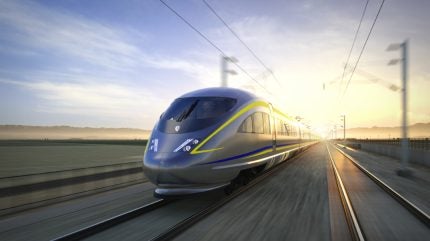
The California High-Speed Rail Authority has cleared environmental assessments for another section of its project, a 494-mile high-speed line between San Francisco and Los Angeles.
The authority’s board approved the penultimate section of phase 1 of the project, a 38-mile segment between Palmdale and Burbank, after reviewing its environmental impact report and impact statement.

Discover B2B Marketing That Performs
Combine business intelligence and editorial excellence to reach engaged professionals across 36 leading media platforms.
The Authority has been appointed as the “lead agency” for the project, under the California Environmental Quality Act (CEQA) and the National Environmental Policy Act (NEPA). It wrote the report to the specifications set by CEQA and NEPA.
Board Chair Tom Richards said: “Today’s approval is more than a historic milestone – it closes the gap between Los Angeles and San Francisco.
“We value our Authority team and its tireless support and collaboration with local and regional agencies and stakeholders as we work together to improve transportation in California for future generations.”
Approval of the section connecting Burbank means 463 miles of the California high-speed line have now been environmentally cleared, with just the Los Angeles to Anaheim segment waiting for approvals, expected to come in 2025.

US Tariffs are shifting - will you react or anticipate?
Don’t let policy changes catch you off guard. Stay proactive with real-time data and expert analysis.
By GlobalDataThe plan for the Palmdale to Burbank section had been altered to reduce the length of tunnelling required under the Angeles National Forest, and now includes 30 miles of tunnels, 28 of which will go through the mountains of Angeles.
News of the approval came as the high-speed rail authority also awarded further contracts for the development of the line, enlisting a joint venture of SYSTRA and TYPSA to design track and overhead contact systems for the initial 171-mile stretch of the project.
The $131.2m contract will see ‘high-level’ designs produced for the systems along the Merced to Bakersfield “initial operating segment” (IOS), which is currently partly under construction and expected to be complete in 2029.
About 119 miles of the IOS is currently under construction and the authority has been working to break ground on the rest of the 171-mile segment, which would be the first part of the project to launch commercial high-speed services.
The slow roll-out of the California High-Speed Line received a significant boost late last year after it was granted $3.07bn in funding from the US Department of Transportation as part of the rail funding from the Bipartisan Infrastructure Law.
Other developments for the project include the shortlisting of Alstom and Siemens as possible manufacturers for the line’s high-speed trainsets ahead of a final decision on the rolling stock contract later this year.



